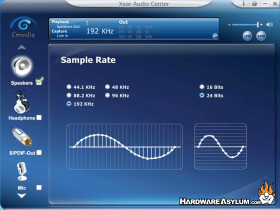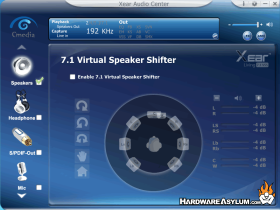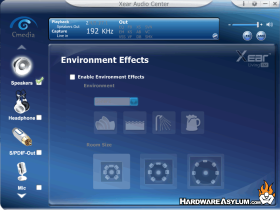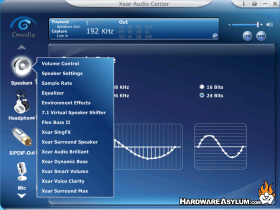Diamond Xtreme Sound 7.1 HD Sound Card Review
Author: Dennis GarciaDrivers Testing and Conclusion
Diamond claims that this card will support full 24-bit audio at 192KHz. Truth is, most onboard audio solutions support this but lack the hardware and/or drivers to make effective use of it. Below are some screenshots from the Xear Audio Center which is the driver application controlling the sound card.
The application may not be much to look at but is very robust allowing you to change frequencies, speaker configurations and even post processing sound effects.
There is a variety of ways to test a sound card depending on what you are looking to get out of your system. For this review we decided to take the obvious approach and assume we are looking for better audio quality.
EVGA X79 Dark - X79 Chipset
Intel Core i7 3960x (3.3Ghz) Hex Core 6 x 256KB L2 Cache 15MB L3 Cache
Thermaltake Water 2.0 Pro
1x nVidia GTX 770
4x Corsair Dominator PC2133 16GB DDR3 (9-11-10-27)
Micron C300 128GB SSD
HP dvd1260i Multiformat 24x Writer
Thermaltake Toughpower Grand 1050 Watt PSU
Windows 7 Ultimate 64bit SP1
Audio Configutation
Onboard 8 Channel HD Audio
Diamond Xtream Sound 7.1
We are using the RightMark Audio Analyzer and a loopback cable to test audio reproduction. In both tests we set the drivers to the highest audio quality setting and for the test to be most accurate both the speaker output and line-in were set to their highest setting supported in the drivers.
Driver Setup
EXGA X79 Dark Input: 192KHz @ 16-Bit / Output: 192KHz @ 24-Bit
Diamond Xtreme Sound Input: 192KHz @ 24-Bit / Ouput: 192KHz @ 24-Bit
Frequency response (from 40 Hz to 15 kHz), dB: +0.02, -0.05 - Excellent
Noise level, dB (A): -95.5 - Excellent
Dynamic range, dB (A): 95.6 - Excellent
THD, %: 0.0093 - Very Good
THD + Noise, dB (A): -68.9 - Average
IMD + Noise, %: 0.040 - Good
Stereo crosstalk, dB: -89.6 - Excellent
IMD at 10 kHz, %: 0.030 - Good
General performance Very Good
Frequency response (from 40 Hz to 15 kHz), dB: +0.03, -0.09 - Excellent
Noise level, dB (A): -93.3 - Very Good
Dynamic range, dB (A): 93.6 - Very Good
THD, %: 0.0012 - Excellent
THD + Noise, dB (A): -87.0 - Good
IMD + Noise, %: 0.0062 - Excellent
Stereo crosstalk, dB: -89.5 - Excellent
IMD at 10 kHz, %: 0.0064 - Excellent
General performance Excellent
Reading audio specs can be a little confusing and in terms of overall audio quality both solutions are really quite good. The Diamond Xtreme Sound 7.1 rates better due to overall noise reductions and lower total harmonic distortion (THD). Distortion is what blows speakers and ear drums so the lower the THD the more accurate your audio reproduction will be.
Over the years there has been a staggering decline in discrete sound card solutions. Many of the big names are still available but, given the prevalence of good onboard solutions many system builders don’t bother installing them.
As we saw in this review the Diamond Xtreme Sound 7.1 tested very well using the RightMark Audio Analyzer and overall found it to be a great upgrade over the onboard solution we tested against. As an added bonus for those looking to build a half height HTPC or SteamMachine the card comes with low profile brackets and the digital break out can be positioned anywhere or removed completely.





